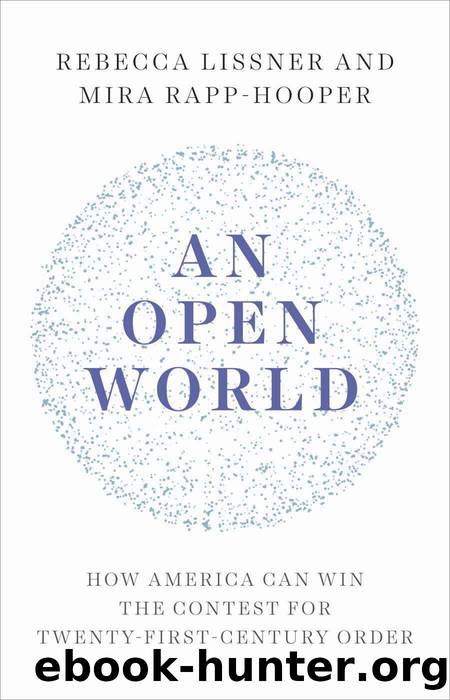An Open World by Rebecca Lissner

Author:Rebecca Lissner
Language: eng
Format: epub
ISBN: 9780300256147
Publisher: Yale University Press
Middle East
In the Middle East, the United States cannot hope to secure openness of the type it seeks in Asia and Europe. Although the region will not become a closed sphere of influence, it will remain highly disordered. To the extent that domestic openness penetrates the region, its reach will be limited by regional rivalries, great-power interference, and civil strife. An openness strategy must work to ensure that a volatile Middle East does not become a threat to openness elsewhere via destabilizing exports of terrorism or migrants, while also preserving free maritime commons in the regionâs strategically vital waterways. Precisely because of the enormous difficulty of establishing regional control for any stateâwhether a regional power or a global oneâan openness strategy can permit additional great-power involvement in regional governance, including economic development projects, freedom of navigation missions, nonproliferation efforts, and multilateral management of migration flows. As the United Statesâ lamentably precipitous withdrawal from Syria has demonstrated, American drawdown may benefit other great powers without necessarily abetting their dominance.
Terrorism and migration, moreover, may result in threats to global openness elsewhere. While an openness strategy cannot hope to wholly eliminate the terrorist threat, it must ensure that the Middle East cannot become a base for attacks on the American homeland or troops stationed overseas. Such an end state does not require a peaceful and democratic region, and it may entail cooperation with some decidedly unsavory local partners in the broader service of an open international system. Amid ongoing civil conflictâexacerbated by the effects of climate changeâmigration will continue to tax international capacity for the absorption of displaced persons. An openness strategy should seek new multilateral arrangements to manage this challenge.
The core openness principle at greatest risk in the Middle East is freedom of navigation. Openness of the global commons will require that Iranian threats to shipping in the Straits of Hormuz remain at bay, including through operations that contest Tehranâs overly expansive interpretation of its rights to restrict navigation. Though not presently under threat, the Suez Canal must remain free and open. In the Horn of Africa, an openness strategy would seek to prevent piracy from endangering international commerce, expanding and further multilateralizing existing counter-piracy efforts, which already count the United States, the EU, NATO, China, India, and Russia as contributors.
With clear great-power threats in Asia and Europe, the United States will need to draw down its Middle East military presence. Enough capability must remain to defeat potential state or nonstate attacks on the homeland or U.S. bases, with persistent devotion of significant intelligence assets. The U.S. Navy should also continue missions in the global commons to promote freedom of navigation. Together, U.S. military and intelligence capabilities should be sufficient to provide âearly warningâ of regional threats that could directly menace the United States or its overseas interests.19 While such a posture necessarily adopts more security risk, the United States will remain deeply engaged in the region diplomatically and economically. It may even begin new initiatives, such as novel regimes to ensure that regional hurdles to global openness are cooperatively managed.
Download
This site does not store any files on its server. We only index and link to content provided by other sites. Please contact the content providers to delete copyright contents if any and email us, we'll remove relevant links or contents immediately.
| Anarchism | Communism & Socialism |
| Conservatism & Liberalism | Democracy |
| Fascism | Libertarianism |
| Nationalism | Radicalism |
| Utopian |
The Secret History by Donna Tartt(18752)
The Social Justice Warrior Handbook by Lisa De Pasquale(12082)
Thirteen Reasons Why by Jay Asher(8738)
This Is How You Lose Her by Junot Diaz(6701)
Weapons of Math Destruction by Cathy O'Neil(6085)
Zero to One by Peter Thiel(5638)
Beartown by Fredrik Backman(5548)
The Myth of the Strong Leader by Archie Brown(5375)
The Fire Next Time by James Baldwin(5200)
How Democracies Die by Steven Levitsky & Daniel Ziblatt(5096)
Promise Me, Dad by Joe Biden(5036)
Stone's Rules by Roger Stone(4989)
100 Deadly Skills by Clint Emerson(4798)
A Higher Loyalty: Truth, Lies, and Leadership by James Comey(4797)
Rise and Kill First by Ronen Bergman(4658)
Secrecy World by Jake Bernstein(4594)
The David Icke Guide to the Global Conspiracy (and how to end it) by David Icke(4557)
The Farm by Tom Rob Smith(4404)
The Doomsday Machine by Daniel Ellsberg(4375)
